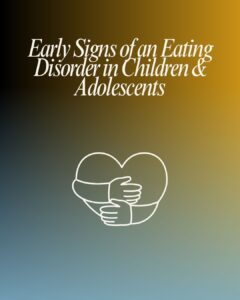In a recent New York Times article, ‘Anorexia in Middle Age and Beyond’” was a powerful reminder that eating disorders don’t “expire” with age. These illnesses can emerge or re-emerge in middle and later adulthood, often masked by the invisibility that can come with age, caregiving roles, and shifting medical focus. I’m truly glad this topic is getting long-overdue attention.
But while we’re talking about it, we also need to step back and ask, “How did we miss this earlier?”
Many of the women interviewed in the article describe disordered eating patterns that began in adolescence or early adulthood—and in many cases, those warning signs were overlooked, minimized, or even normalized. This highlights a crucial message: we cannot afford to ignore early signs of eating disorders in children and teens. The longer these behaviors go unrecognized and untreated, the more deeply rooted they can become.
Early Signs Matter—Even If They Don’t Look “Severe”
In childhood and adolescence, eating disorders may not always present in dramatic or obvious ways. Here are some signs that might be missed or brushed off as “phases”:
- Skipping meals or consistently eating less at family meals
- Suddenly becoming rigid or perfectionistic about food choices
- Eating in secret or avoiding eating in front of others
- Increased anxiety or emotional dysregulation around food or body image
- Rapid changes in weight or slowed growth in a child or teen who’s still developing
- Body checking, frequent weighing, or constant negative talk about their appearance
- Obsession with exercise, health, or “clean eating”
These signs may not immediately scream “eating disorder,” but together—or even in isolation—they can indicate something is off.
Why Early Recognition and Treatment Matters
Eating disorders are treatable, and earlier intervention improves outcomes. That’s not just a hopeful sentiment—it’s what research shows us, time and time again. When families, pediatricians, and schools are equipped to recognize warning signs early, young people have a better chance at full and lasting recovery.
And perhaps even more importantly—we have the chance to interrupt the trajectory that could lead someone to be struggling with an eating disorder well into adulthood, silently and unseen.

Bottom line? I’m grateful that the NYT is shining a light on eating disorders in older women. But let’s not wait until someone is 45 or 65 to name what started when they were 12. Let’s start paying attention sooner—and acting with care, clarity, and urgency.
